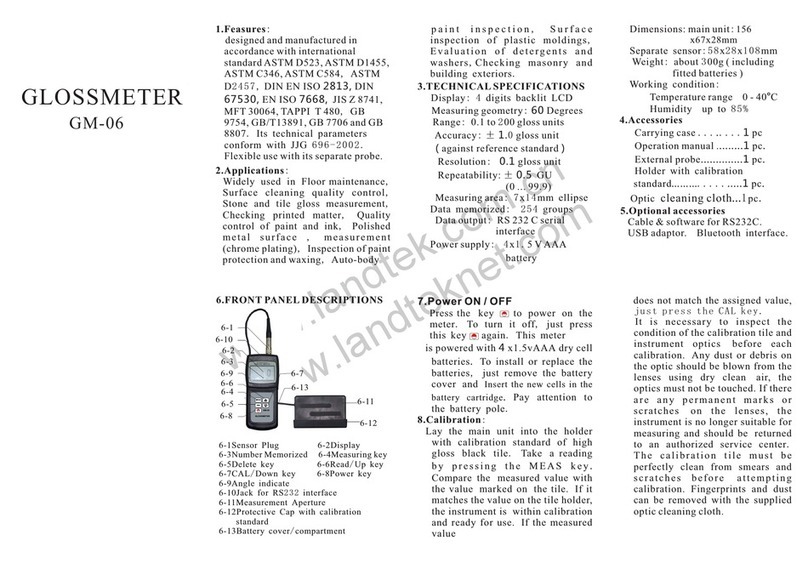
www.landtek.com.cn
www.landteknet.com
7.1 Clean the ORP electrode with de-ionized or
distilled water.
7.2 Place the electrode in the mv buffer solution.
7.3 When display stabilizing, check if the
reading on the display is close to the standard
value of mv solution. If the error lies in ±35
mv. If yes, indicates the electrode tested can
still be used. If not, replace it by new one.
The High setting determines the operating
parameters for Relay High; while low setting
defines the operating parameters for Relay Low.
8.HIGH AND LOW SETTINGS FOR PH
HiAL on the upper section of the Display. It
takes about 3 second from pressing the M key.
Then Press the up key or down key to
adjust the digit on the auxiliary section to the
desired value which controls the high relay
output.
section. Input the hysteresis value (dead
band) on the auxiliary section by Pressing the
up key or down key . e.g. to control the PH
value between 9-10 by adding acid, just set
HiAL to "10", and hb to"1".
section. Then Press the up key or down key
to adjust the digit on the auxiliary section
to the desired value which controls the low
relay output.
8.1 Press the M key and not release it until the
8.2 Press the M key and hb shows on the main
8.3 Press the M key and LoAL shows on the main
》
》
》
》
》
》
CONTROLLER
6
Carefully unpack the instrument and accessories.
Inspect for any damages made in shipment. The
Controller shall be installed and operated only in
the manner specified in the Instruction manual.
Only skilled, trained or authorized person should
carry out installation, setup and operation of the
4.ASSEMBLY AND INSTALLATION
instrument.
Please follow steps below.
A.Installation of composite electrode.
b.Installation of PH/ORP controller
c.Connect the probe to the controller by an
appropriate cable.
d.Connect the pump or electromagnetic valve
e.Power on the controller
f.Calibrate the controller using the standard
sample.
g.Set the control limits
PH/ORP
A/PH
RP
A/R
A typical system is shown bellow.
A/PH: a Relay contact inside of the PH/ORP
controller
A/R: a contact of the power relay
3
R: a power replay
P: pump or valve
M (3 s)
M
Hb/0.00
LoAL/0.00
Lb/0.00
CS/0
CH/20.00
Fun/PH
CAL/......
Display
HiAL/0.00
M
M
M
M
M
M
Low limit, adjusted by the up key or down
Hysteresis value (Dead Band) for High limit,
adjusted by the up key or down key
High limit, adjusted by the up key or down
Hysteresis value (Dead Band) for Low limit,
adjusted by the up key or down key
Set value for manual temp. Compensation
adjusted by the up key or down key
Indication of current use: PH or ORP
changed by the up key or down key
2-point calibration
please refer to Calibration part for detail.
Status key
Key
=0: without temperature compensation
=1:
=2:
manual temperature compensation
automatic temperature compensation
Auxiliary value
》
》
》
》
》
》
》
》
》
》
》
》
5. MENU OPERATION DIAGRAM
6.PH CALIBRATION
6.1 Clean the pH electrode and temperature probe
6.2 Place the electrode in the first buffer(PH6.86)
solution. In ATC mode, you must also immerse
with de-ionized or distilled water.
4
M
》
》
temperature probe in the buffer solution.
just press the M key and not release it until the
HiAL on the upper part of the Display. It takes
about 3 second from pressing the M key. Then
press and release the M key till CAL on
the main section and ---- on the auxiliary
the
6.3 When the reading on the display is stabilizing,
section.
6.4 Press the up key or down key to select P1
shows on the auxiliary section.
6.5
adjust to 6.86 by the up key or down key .
6.6 Press key and 6.86 shows on the main
section.
6.7 Press the up key or down key to select
yes shows on the auxiliary section.
6.8 Press the M key and P1 shows on both main
and auxiliary sections.
6.9 After a second, CAL shows on the main
section and ---- on the auxiliary section.
above procedures makes P1 calibration ok.
6.10 Repeat steps from 6.1 to 6.9, just change the
PH buffer (standard) to PH4.00 (or 9.18), and
P2 replacing P1 to complete the P2 calibration.
And 6.86 on the auxiliary section. if not 6.86,
》
》
section and no shows on the auxiliary
》
》
7.ORP CALIBRATION
To calibrate ORP electrode does not need PH
buffer instead of mv buffer to test if the ORP
electrode is still workable.
5
M
Press the key, and P1 shows on the main section





















